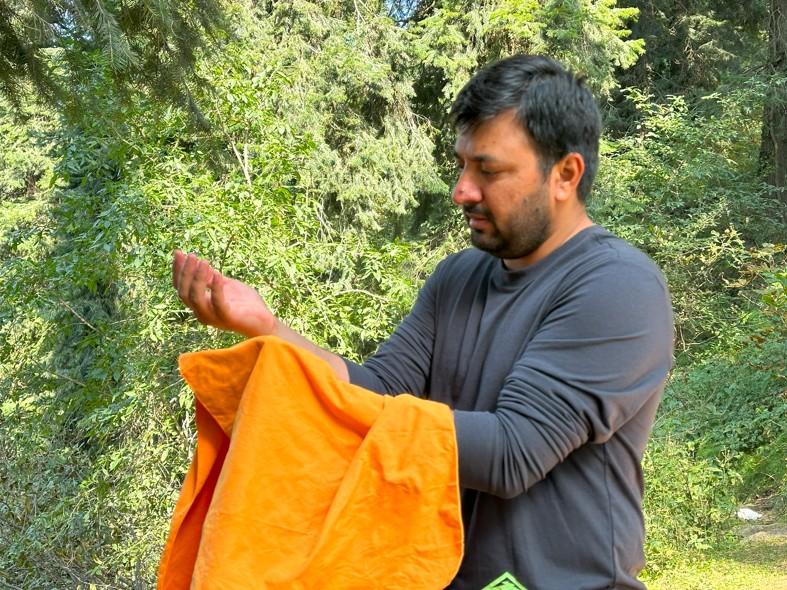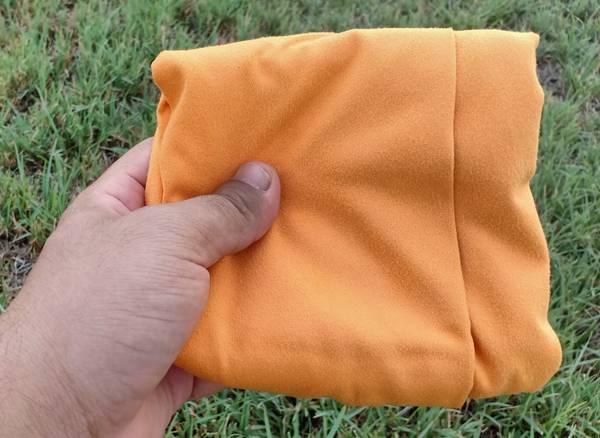Our overall impressions of the Sea to Summit Drylite Towel are based on extended use across a variety of trail environments, including desert treks and alpine climbs. What stands out most is how well this towel blends weight, packability, and function for backcountry travelers who demand more than just a strip of fabric. After testing it across environments—from humid jungles to dusty desert hikes—it proved to be handy outdoor gear.
Related: Best Camping Towels
In this review, I’ll take you along on multi-day hikes in both blazing heat and brisk mountain air, reflecting on how this towel performed at camp, river crossings, and along the trail. You’ll get real-world insights: how fast it dries, how it handles sweat and grit, and whether it can genuinely feel like a comfort item—or just another pack filler.
By the end, you’ll know if the Drylite’s compact size and fast-dry claims hold up in the real world—and whether it’s earned its place in your pack.
Editor’s Note: This post was originally written based on real-world testing across high-altitude Himalayan trails and arid Middle Eastern deserts. It was last updated on June 14, 2025 to reflect long-term use, trail-tested insights, and updated comparisons to other popular backpacking towels. All observations are based on personal experience in field conditions.
How I Tested It in the Wild
The Sea to Summit Drylite Towel first made its way into my pack on a hot, windblown trek through UAE sands. I wasn’t expecting to use it much apart from using it as a bath towel. But it earned a regular spot in my rotation.
Since then, I’ve used this towel in different environments: a multi-day monsoon trek through jungle trails and a high-altitude expedition near Nanga Parbat. It dried fast on cold mornings. In the jungle, it was almost dry within an hour—even under cloudy skies. In the mountains, it never stiffened like thicker towels I’ve used in similar conditions.

I tested the medium-sized version—large enough to handle a full-body dry-off but compact enough to tuck easily into a side pocket or mesh sleeve.
What surprised me most was how little compromise the Drylite demanded. It was quick-drying, just soft enough, and light enough that I never questioned packing it.
Most of my field testing happened in tough, varied conditions—from the cold, thin air of the Himalayas to the sun-beaten trails of the Middle East. These environments are demanding, and they test gear the same way U.S. trails do—whether you’re navigating Utah’s slickrock country or slogging through the Pacific Northwest’s damp underbrush. Through it all, the Drylite kept up—and that’s what this review is based on: how it really performs, far from the product specs.
Performance Comparison and Testing Results
Absorbency & Dry Time
In dry desert air, it dries in 30–60 minutes in full sun—sometimes faster with wind. In colder, damp conditions like the Himalayas, expect closer to 90 minutes. Still, it outpaces any cotton towel I’ve carried and doesn’t stay wet long enough to become a burden.

I’ve noticed that if you pack it without drying, it naturally takes longer to dry later—which you’d expect. But what stood out is that even when packed wet, it didn’t produce any odor. That’s a big deal on the trail, where drying time isn’t always a luxury—you sometimes just pack up and go. The Drylite really shines in those moments.
Over multi-day hikes, I got 3–4 days of use before needing to wash it. It held off odors better than thicker microfiber options, which tend to smell after just a day or two.
Compared to other backpacking towels—like REI’s Multi Towel or PackTowl’s Personal—the Drylite is lighter and dries just as fast. Its texture is a bit slicker, but it’s a fair trade-off for performance.
If you need something quick-drying, odor-resistant, and low-maintenance, the Drylite is one of the more reliable towels I’ve used on the trail.
Packability & Weight
One of the things I appreciate most about the Drylite is its weight-to-packability ratio. It packs down so small that I was even able to put it in my pocket. The medium size has been more than enough for full-body drying after a wash, which I was not expecting. When in a hurry or if it’s wet, I put it into a side mesh pocket, and it fits easily.

Dry, it weighs just under 3 ounces—barely noticeable on multi-day hikes. Even when wet, it doesn’t feel like you’re carrying a soaked brick—more like a damp T-shirt. I usually wring it out, clip it to the back of my pack, and within an hour or two, it’s good to go again.
What sets it apart is how low-maintenance it is. I’ve used other “quick-dry” towels that stayed soggy for hours, especially in cooler or humid conditions. With the Drylite, even after a rinse in high humidity or alpine chill, I never had to deal with a cold, clammy towel in the morning. It dries fast enough to stash without worrying about mildew or wetting your other gear.
For ultralight hikers—or anyone counting ounces—the weight-to-performance ratio is excellent. Sure, you could go without a towel or carry something smaller, but the Drylite packs so small and works so well, there’s little reason to leave it behind.
Comfort & Feel
Most ultralight towels feel a bit strange at first, and the Drylite is no different. Out of the box, it has a slightly slick texture that doesn’t exactly feel like your comfortable cotton towels. But out on the trail, comfort isn’t about softness really—it’s about not irritating your skin.

In that context, the Drylite holds up well. No, it’s not cotton-soft, but it also doesn’t feel scratchy or cheap. What I have noticed is that after a couple of uses and washes, it softens slightly. So even if your skin is sensitive, this towel shouldn’t be an issue.
The real bonus is how little effort it takes to dry off. You don’t need to rub aggressively like with a traditional towel. It’s trail comfort—the practical kind.
Durability & Maintenance
After more than a year of use, including multiple back-to-back trips and a dozen or more machine washes, the Sea to Summit Drylite Towel is still holding up better than I expected for something this lightweight.
I’ve used it on desert trails, during monsoon hikes, and at muddy alpine campsites. Each time, it came home looking a little rough, but with a quick rinse, it bounced back. The stitching along the edges has stayed intact, the fabric hasn’t frayed, and most importantly, it hasn’t lost its absorbency.
In terms of softness, I’d say it’s held up well. The suede texture flattens out slightly over time, especially if you’re not gentle with how you wash it. I’ve always run it through a gentle cycle with cold water and let it air dry. That seems to preserve the feel much better than tossing it in a hot dryer—which I tried once. It came out a bit stiffer than I liked, though it softened up again after a couple of uses.
It needs low maintenance, is quick to clean, and is durable—making it a practical choice for multi-day backpacking.
Who This Towel Is For (and Who It’s Not)
The Sea to Summit Drylite Towel is for people who actually use their gear. If you’re out on multi-day hikes, traveling, and want to keep the pack size compact, this towel makes sense. It’s light, it dries quickly, and it doesn’t stink after one sweaty day on the trail. After using and testing it on different terrains, I recommend this towel based on its performance.
Where it really comes in handy is on hot, dusty treks when you need to wipe sweat more often. It doesn’t stay soggy, and you don’t have to treat it like something delicate. Use it, and just put it in your pack’s mesh pocket—it’s simple.
But if you’re car camping or staying at a basecamp and want something cozy to wrap up in, this probably isn’t it. The Drylite isn’t trying to be soft and fluffy. It’s not your home towel. It’s a trail tool—simple, light, and built to do its job without getting in the way.
If you care more about function, packability, and portability, this towel will feel like the right choice.
Comparison With Other Backpacking Towels
I’ve tried a handful of quick-dry towels over the years, and while most of them work well enough, a few stand out for different reasons. Here’s how the Sea to Summit Drylite Towel stacks up against two popular options you’ll see in a lot of packs: the Rainleaf Microfiber Towel and the PackTowl Personal.
Sea to Summit Drylite vs. Rainleaf Microfiber Towel
The Rainleaf towel is often the go-to for budget-conscious hikers. It’s affordable, dries reasonably fast, and comes with a snap loop and mesh bag. But in actual use, I found it a bit bulkier and slower to dry than the Drylite, especially in cooler or humid conditions.
The Rainleaf also tends to hold onto a bit more odor if you don’t air it out properly. It’s softer out of the box, but it doesn’t feel quite as dialed in for multi-day backcountry use.
• Weight: Slightly heavier than Drylite
• Feel: Softer, fluffier texture
• Drying Time: Slower than Drylite in damp conditions
• Price: More budget-friendly
Sea to Summit Drylite vs. PackTowl Personal
The PackTowl Personal has been around for a while, and it’s a solid all-around choice. It’s super absorbent and comes in a variety of sizes. Compared to the Drylite, it’s a touch thicker and arguably a bit more comfortable, especially for sensitive skin.
But with that comfort comes slightly slower dry times and a bit more pack bulk. I’d call it the better option for car camping or short trips where weight isn’t critical. On longer hikes, I’d still give the edge to the Drylite for its packability and fast turnaround between uses.
• Weight: Slightly heavier
• Feel: Softer, more cloth-like texture
• Drying Time: Comparable, but marginally slower
• Price: Around the same depending on size
Final Verdict: Is the Sea to Summit Drylite Worth It?
After taking the Drylite through everything from freezing alpine mornings to hot, gritty desert trails, I can say it’s more than earned its place in my pack. It’s not luxurious, but it nails the basics: it dries fast, packs small, and holds up over time.
I’ve been using it for well over a year now, and it still goes with me on every trip. It’s one of those pieces of gear you don’t think much about… because it just works.
Would I buy it again? No question. If you’re a hiker, thru-trekker, or just someone who wants a no-fuss trail towel that does its job and stays out of the way, the Drylite’s a solid call. It’s not fancy—but when you’re out in the wild, that’s exactly what you want.
